AMAZON multi-meters discounts AMAZON oscilloscope discounts
The popularity of pocket-size radios shows how well the transistor has been accepted for entertainment use. Because of their small size, transistors allow designers to make use of many space saving techniques. The result is a compact circuit with all the features of its counterpart, the tube-type radio.
One such transistor circuit shown here is the autodyne converter-a combination local oscillator, mixer, and first IF stage.
AUTODYNE
In the oscillator section of Circuit A, random noise produces a slight base-current variation which is subsequently amplified to produce a larger variation in collector current. This alternating current appears in the primary of autotransformer L2 and induces an AC current in the secondary ( L2 is tuned to the desired oscillator frequency by CB). C4 then couples the resonant-frequency signal back to the emitter circuit. If the tickler winding of L2 is properly phased, its feedback will be positive (regenerative) and of the proper magnitude to cause sustained oscillations.
The secondary of L2 provides a proper impedance match be tween the high-impedance tank circuit of L2 and the relatively low impedance of the emitter circuit.
In the mixer action, the ferrite rod antenna is tuned by C2 and the incoming RF is coupled to the base of the 2N1087 transistor.
Because of its low bias, this transistor is operating along a non linear portion of its curve. As a result, the stage mixes the RF and local-oscillator signals, providing an output which consists of both the original frequencies plus both the sum and difference frequencies. The autotransformer in the collector circuit is tuned by its capacitor to only the difference frequency, which is usually the 455-khz IF.
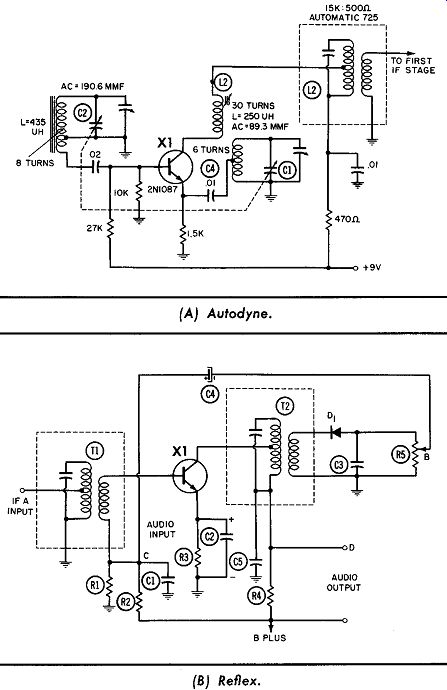
------------- Radio Circuits.
(A) Autodyne. (B)Reflex.
REFLEX
A reflex circuit is one in which two frequencies are amplified by the same stage. For example, it may amplify an IF signal and then, after its detection, also amplify the audio modulation.
Circuit B shows such an amplifier. The IF is amplified in the usual manner, after which it is detected by the diode. Audio across the volume control is fed to point C through C4.
The secondary of T2 consists of only a few turns of wire. ( In essence, it is a short circuit at audio frequencies.) C1 bypasses the IF signal otherwise appearing across the parallel combination of R1 and R2. Emitter resistor R3 is bypassed for both audio and IF by electrolytic capacitor C2. After amplification, the audio signal appears across R4. From there it is fed to the audio-output stage. C5 bypasses R4 for IF frequencies.
The advantage of a reflex circuit is that only one stage is needed to produce the necessary gain, instead of two. The savings in cost, space, and battery drain make such a circuit worth while. Its disadvantages are that the design is considerably more difficult to produce, and the play-through (i.e., signal output with volume control at zero setting) is somewhat higher. Also, there is a minimum volume effect, which occurs at slightly higher than zero volume-control setting). At this point, the signal is distorted because the fundamentals from the normal signal balance the out-of-phase play-through component.
SUPERHETERODYNE
In the superheterodyne receiver, the incoming RF signal is mixed with a high-frequency oscillator signal. The difference (IF) between these two signals is then amplified before being rectified to recover the audio modulation.
Of these three types of receivers (autodyne, reflex, and super heterodyne), the superheterodyne provides the highest selectivity, sensitivity, fidelity, gain, and control. For these reasons it is the most popular design in today's radios.

---------------- NOMINAL SENSITIVITY: 600MICROVOLTS/METER (MEASURED WITH
5 MILLIWATTS REFERENCE POWER OUTPUT) MAXIMUM POWER OUTPUT : 75 MILLIWATTS SELECTIVITY
AT-6db: IOKC SELECTIVITY AT -60db : 120 KC TOTAL BATTERY DRAIN . : 17, 5 MILLIAMPS
WHERE REQUIRED T2: RADIO INDUSTRIES 118223 OR AUTOMATIC BS-6146 T3:20K/ IKA
T4 :450.n./V.C. AUDIO TRANSFORMERS- I 5/8 BY I 3/8 BY 1/2 INCH STACK OSCILLATOR
COIL-ED STANWYCK 1265 VARIABLE CAPACITOR-RADIO CONDENSER 242

---------------
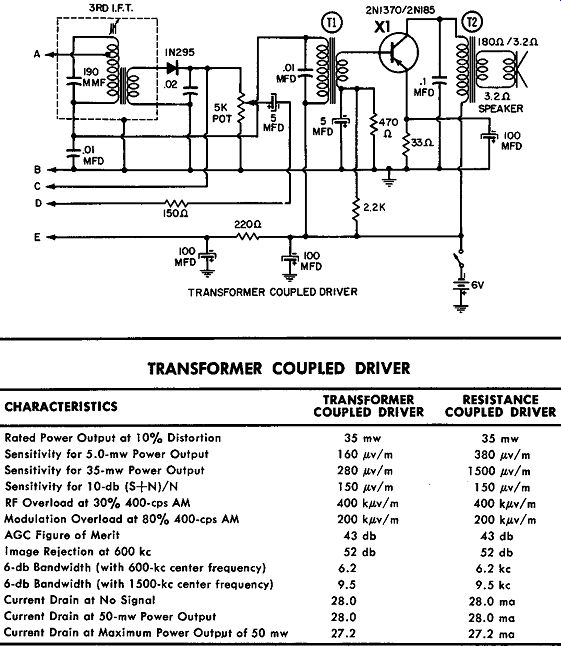
-------------- TRANSFORMER COUPLED DRIVER

---------------- IF TRANSFORMER DATA
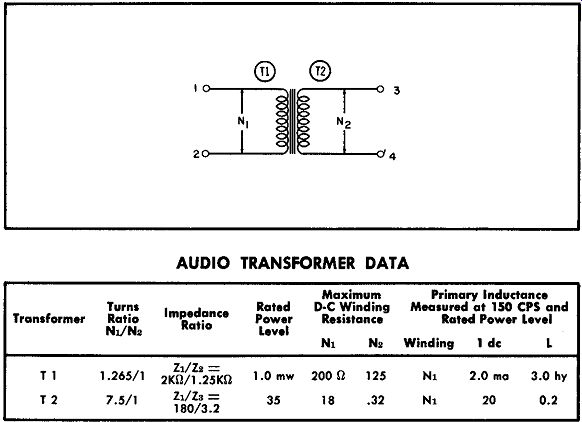
-------------- AUDIO TRANSFORMER DATA
ANTENNA BAR DATA
I. Ferrite Bar Sjze II. Winding Data Length
................................•...•.....••... 3.68 inches
Width ..............................•...............• 0.725 inch
Thickness ...•......••...•............................ 0.125 inch
A. Primary 1. Wire size .............................•.. #32 AWG heavy Formvar
2. Length of winding .........................•....•....... 2'½• inches
3. Number of lurns ........................••••..........•.....•
119 B. Secondary
1. Wire size ..•...•.••.......•.......••..•...•. #35 AWG, Gripeze-2
2. Length of winding ..............•...........•.•........... '½2 Inch
3. Number of turns ........................•.••••.........•...... 17
4. Method of winding ......................
Bifilar with start of primary
111. Electrical Characteristics Lp = 660µh Q unloaded (at 550 khz) = 295 Q unloaded (al 1000 khz) = 290 Q loaded (al 1 mhz with 5000-ohm load across secondary) ~73 Coefficient of Coupling, k~0.60 Distributed Capacity, Cdist gw 2.0 µµf Output voltage (with I;= O. lv/m and secondary load= 5000 ohms)= 5mv

-------------- OSCILLATOR COIL DATA
Coil Form ....•....................•... EL-RAD #30B801 Core ............••••............ EL-RAD, Ferrite 21B100 Base ................................ 6 Pin #2B100-1 Wire .....................•...... #40 AWG, Gripeze-2 Type Winding •....................................
2 Pi Spacing between Primary and Secondary ............ 0.1 inch Cam Size ....•.......•.•.•................. 0.093 inch Gear Ratio .................•.•................. 39,41 Idler Ratio ....•............................•..... 1, 1

---------------

---------------- 5 Transistor-reflex 6-V Radio
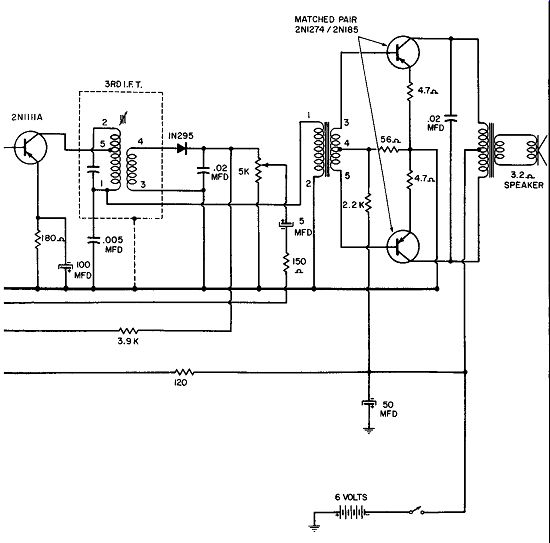
--------------------
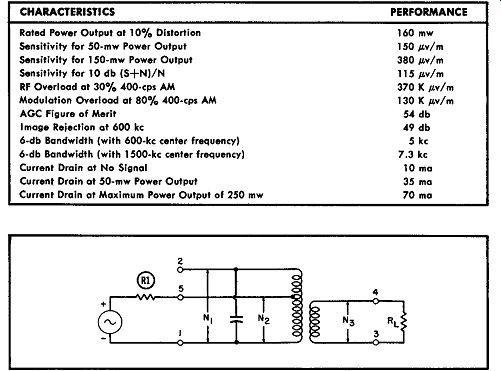
------------------ TYPICAL PERFORMANCE CHARACTERISTICS

------------------ IF TRANSFORMER DATA
----------------- AUDIO TRANSFORMER DATA

------------------- OSCILLATOR COIL DATA
Coll Form ............................. EL-RAD #30B801 Core ............................ EL-RAD, Ferrite 21B100 Base ................................... 6 Pin #2B100 Wire ............................ #40 AWG, Gripeze-2 Type Winding ..................................... 2 Pi Spacing between
Primary and Secondary ............ 0.1 inch
Cam Size .................................. 0.093 Inch Gear Ratio ..................................... 39,41 Idler Ratio ....................................... 1 , 1

------------------------ ANTENNA BAR DATA
I. Ferrite Bar Size Length .............................................. 3.68 inches Width ............................................... 0.725 inch Thickness .................................... · ........ 0. 125 inch
II. Winding Data A. Primary 1. Wire size ............. , ................... #32 AWG heavy Formvar
2. Length of winding ...................................... 2'½• inches
3. Number of turns .............................................
119 B. Secondary
1. Wire size ................................ #32 AWG, heavy Formvar
2. Length of winding ........................................ 1Yn Inch
3. Number of turns .............................................. 17
4. Method of winding ...................... Bilfllar with start of primary 111.
Electrical Characteristics
Lp = 680 µ,h Q unloaded (at 550 khz) = 295 Q unloaded (at 1300 khz) = 280 Q loaded (at 1 mhz with 5000-ohm load across secondary)~ 73 Coefficient of Coupling, k~ 0.60 Distributed Capacity, Cdlota!2.0 µ,µ,f
Output voltage (with f = 0. lv/m and secondary load= 5000 ohms)= 5mv
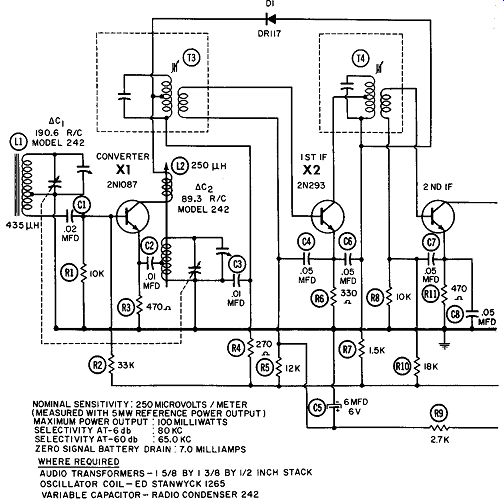
----------------- Six transistor, 3-volt superheterodyne.
NOMINAL SENSITIVITY: 250 MICROVOLTS / METER (MEASURED WITH 5MW REFERENCE POWER OUTPUT) MAXIMUM POWER OUTPUT : 100 MILLIWATTS SELECTIVITY AT-6 db : 80 KC SELECTIVITY AT-60 db : 65.0 KC ZERO SIGNAL BATTERY DRAIN. 7.0 MILLIAMPS WHERE REQUIRED AUDIO TRANSFORMERS- I 5/8 BY I 3/8 BY 1/2 INCH STACK OSCILLATOR COIL-ED STANWYCK 1265 VARIABLE CAPACITOR- RADIO CONDENSER
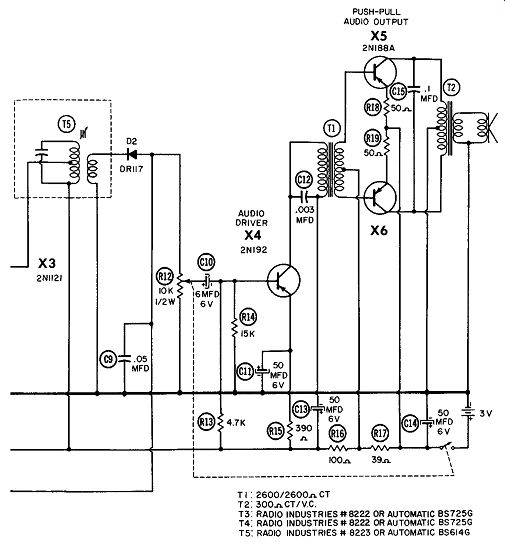
------------------ T1 . 26OO/26OO.n. CT T2: 3OO.n.CT/V.C. T3: RADIO INDUSTRIES
lt8222 OR AUTOMATIC BS725G T4: RADIO INDUSTRIES lt 8222 OR AUTOMATIC BS725G
T5: RADIO INDUSTRIES It 8223 OR AUTOMATIC BS614G

------------------- Six transistor, 12-volt superheterodyne.

------------------- WHERE REQUIRED T1 : 2000/2600 CT T2: 200.n. CT /VC
T3 : AUTOMATIC EX0-5460 T4 : AUTOMATIC EX0-5460 T5: RADIO INDUSTRIES1t8223
OR AUTOMATIC EXO- 3015 OR BS614G AUDIO TRANSFORMERS-I 5/8 SY I 3/8 SY 1/3.
2 INCH STACK OSCILLATOR COIL- ED STANWYCK 1265 VARIABLE CAPACITOR - RADIO CONDENSER